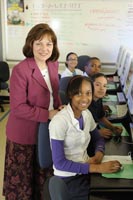A School Built on Hope
July 8, 2010 - "In a happy accident of geography, the builders set this school down on Hope Street. We're standing inside, but we are actually on Hope Street — it runs through our central hallway and out on the other side," explains Principal Cristina Alvarez.
 "Hunter School is quite literally, a school built on Hope," she continues. "We are also figuratively, a school built on hope because we exist to prepare children who come from poverty, with 21st century skills. It's a big job."
"Hunter School is quite literally, a school built on Hope," she continues. "We are also figuratively, a school built on hope because we exist to prepare children who come from poverty, with 21st century skills. It's a big job."
Alvarez, a graduate of Penn GSE's Mid-Career Doctoral Program in Educational Leadership, came to Hunter from a position in the School District of Philadelphia's Office of Accountability. She'd been a principal before — at the Charter High School for Architecture & Design (CHAD) — but she knew precious little about Hunter when the District offered her the job.
"Nothing about the school existed on the website that gave me any serious clues about what was happening here, that it was a community school with so much potential. All I knew was that accountability data was pretty dire — the school had not made adequate yearly progress for seven years."
But Alvarez was intrigued — she was born 11 blocks away from Hunter and understood the challenges its students faced — and plunged into her new school with characteristic enthusiasm.
In her two short years there, Alvarez has transformed Hunter: there is a new design technology lab unique in the city, 85 laptops funded through a Classrooms for the Future grant, a Oui Love to Learn! French language and culture program, and Schweitzer Fellow pharmacists who teach wellness classes to parents — plus partnerships with an opera company, PNC Bank, and the Computer Clubhouse Network. A socialized recess program, a Discovery Zone for students with special needs, a partnership with the Norris Square Civic Association that offers an on-site after-school program, and a growing tradition of teacher inquiry and practitioner research all support an improved culture of learning.
Alvarez is a forceful presence in the school, and she credits GSE's Mid-Career program with helping her through a challenging leadership transition. "The beauty of the program," she says, "is that it happens while you're working in an educational setting."
During her first year in the program, when Alvarez was working in the Office of Accountability, her research focused on educational technology. She was studying the Science Leadership Academy — a high school that was operated as a partnership between the District and the Franklin Institute Science Museum.
Year Two found her as the principal of a low-achieving PreK-8 school in one of Philadelphia's poorest neighborhoods. But Alvarez discovered shortly after her arrival at Hunter that the school had been created as a technology reform model school several years earlier. Although the digital reforms had faded, the original vision for Hunter had been a partnership with K12 Inc., an on-line curriculum provider — in effect, the elementary equivalent of the Science Leadership Academy.
"I came to see how my research at the Science Leadership Academy and my work here at Hunter converged," she says. "I realized that what I was studying was deeply applicable to what I was doing."
Alvarez had come into the Mid-Career program asking hard questions about leadership and reform. As the turnaround principal at CHAD, she had always wondered whether its model was replicable. Why do certain innovative models, certain schools take off? What do the leaders in those schools do to create success? What can be learned from their experience?
As Alvarez explains, "Because it is practical and asks you to apply what you're learning in the real world, the Mid-Career program is perfect for examining those kinds of questions. The questions I had about leadership for nearly ten years, I ended up answering here.
"I was learning about leadership and applying it to my own work every day, taking qualitative field notes, inquiring into my own practice, getting feedback from my cohort members. All those things wove together and I realized that there was an innovation story here at Hunter."
The lesson of Hunter's turnaround is that it is possible to create a model school in a high-poverty community school. As Alvarez says, "You don't need a highly selective school with perfect conditions. Initially we had the meager resources as other high-poverty schools. The leadership story here is that we are a school of innovation with ordinary kids, with teachers who are growing in their professional practice — and in a neighborhood context. As stories emerge of Hunter's successes, we are building and attracting much needed social and financial capital."
In an age of accountability perhaps the most compelling evidence of a successful school turnaround are improved test scores. Hunter students' PSSA test scores for reading and math are phenomenal across the board.
To read more about the answers Alvarez found, click here.
